Characterizing Gas Hydrate-Bearing Marine Sediments Using Elastic Properties—Part 2: Seismic Inversion Based on a Pore-Filling–Solid Matrix Decoupling Scheme
Abstract
1. Introduction
2. Methods
2.1. Pore-Filling–Solid Matrix Decoupling AVO Equation
2.2. AVO Inversion Based on the Pore-Filling–Solid Matrix Decoupling Scheme
3. Results
3.1. Elastic Properties and Seismic Responses of Gas Hydrate-Bearing Sediments
3.2. Theoretical Model Test of the Decoupling AVO Inversion
3.3. Realistic Model Test of the Decoupling AVO Inversion
4. Discussion
5. Conclusions
Author Contributions
Funding
Institutional Review Board Statement
Informed Consent Statement
Data Availability Statement
Conflicts of Interest
Appendix A
References
- Guo, Z.Q.; Lv, X.Y.; Liu, C.; Chen, H.F.; Cai, Z.G. Characterizing gas hydrate–bearing marine sediments using elastic properties—Part 1: Rock physical modeling and inversion from well logs. J. Mar. Sci. Eng. 2022, 10, 1379. [Google Scholar] [CrossRef]
- Andreassen, K.; Hogstad, K.; Berteussen, K.A. Gas hydrate in the southern Barents Sea indicated by a shallow seismic anomaly. First Break 1990, 8, 235–245. [Google Scholar] [CrossRef]
- Andreassen, K.; Hartb, P.E.; MacKayc, M. Amplitude versus offset modeling of the bottom simulating reflection associated with submarine gas hydrates. Mar. Geol. 1997, 137, 25–40. [Google Scholar] [CrossRef]
- Carcione, J.M.; Tinivella, U. Bottom simulating reflectors: Seismic velocities and AVO effects. Geophysics 2000, 65, 54–67. [Google Scholar] [CrossRef]
- Ecker, C.; Dvorkin, J.; Nur, A.M. Estimating the amount of gas hydrate and free gas from marine seismic data. Geophysics 2000, 65, 565–573. [Google Scholar] [CrossRef]
- Chen, M.P.; Riedel, M.; Hyndman, R.D.; Dosso, S.E. AVO inversion of BSRs in marine gas hydrate studies. Geophysics 2007, 72, C31–C43. [Google Scholar] [CrossRef]
- Dai, J.; Snyder, F.; Gillespie, D.; Koesoemadinata, A.; Dutta, N. Exploration for gas hydrates in the deepwater northern Gulf of Mexico: Part I. A seismic approach based on geologic model, inversion and rock physics principles. Mar. Petr. Geol. 2008, 25, 830–844. [Google Scholar] [CrossRef]
- Dai, J.; Banik, N.; Gillespie, D.; Dutta, N. Exploration for gas hydrates in the deepwater, northern Gulf of Mexico: Part II. Model validation by drilling. Mar. Petr. Geol. 2008, 25, 845–859. [Google Scholar] [CrossRef]
- Dutta, N.C.; Dai, J. Exploration for gas hydrates in a marine environment using seismic inversion and rock physics principles. Lead. Edge 2009, 28, 792–802. [Google Scholar] [CrossRef]
- Shelander, D.; Dai, J.; Bunge, G. Predicting saturation of gas hydrates using pre-stack seismic data, Gulf of Mexico. Mar. Geophys. Res. 2010, 31, 39–57. [Google Scholar] [CrossRef]
- Shelander, D.; Dai, J.; Bunge, G.; Singh, S.; Eissa, M.; Fisher, K. Estimating saturation of gas hydrates using conventional 3D seismic data, Gulf of Mexico Joint Industry Project Leg II. Mar. Petr. Geol. 2012, 34, 96–110. [Google Scholar] [CrossRef]
- Fohrmann, M.; Pecher, I.A. Analysing sand-dominated channel systems for potential gas-hydrate-reservoirs using an AVO seismic inversion technique on the Southern Hikurangi Margin, New Zealand. Mar. Petr. Geol. 2012, 38, 19–34. [Google Scholar] [CrossRef]
- Zhang, Z.J.; McConnell, D.R.; Han, D.H. Rock physics-based seismic trace analysis of unconsolidated sediments containing gas hydrate and free gas in Green Canyon 955, Northern Gulf of Mexico. Mar. Petr. Geol. 2012, 34, 119–133. [Google Scholar] [CrossRef]
- Dewangan, P.; Mandal, R.; Jaiswal, P.; Ramprasad, T.; Sriram, G. Estimation of seismic attenuation of gas hydrate bearing sediments from multi-channel seismic data: A case study from Krishna-Godavari offshore basin. Mar. Pet. Geol. 2014, 58, 356–367. [Google Scholar] [CrossRef]
- Qadrouh, A.; Carcione, J.M.; Salim, A.M.; Harith, Z.Z.T. Attenuation effects on the seismic response of a bottom-simulating reflector. J. Nat. Gas Sci. Eng. 2015, 24, 510–517. [Google Scholar] [CrossRef]
- Ehsan, M.I.; Ahmed, N.; Khalid, P.; Liu, X.W.; Naeem, M. An application of rock physics modeling to quantify the seismic response of gas hydrate-bearing sediments in Makran accretionary prism, offshore, Pakistan. Geosci. J. 2016, 20, 321–330. [Google Scholar] [CrossRef]
- Han, D.; Batzle, M. Gain function and hydrocarbon indicators. In Proceedings of the SEG Annual Meeting, Dallas, TX, USA, 26–31 October 2003. [Google Scholar]
- Russell, B.H.; Hedlin, K.; Hilterman, F.J. Fluid-property discrimination with AVO: A Biot-Gassmann perspective. Geophysics 2003, 68, 29–39. [Google Scholar] [CrossRef]
- Russell, B.H.; Gray, D.; Hampson, D.P. Linearized AVO and poroelasticity. Geophysics 2011, 76, C19–C29. [Google Scholar] [CrossRef]
- Zong, Z.Y.; Yin, X.Y.; Wu, G. Direct inversion for a fluid factor and its application in heterogeneous reservoirs. Geophys. Prospect. 2013, 61, 998–1005. [Google Scholar] [CrossRef]
- Yin, X.Y.; Cao, D.P.; Wang, B.L.; Zong, Z.Y. Research progress of fluid discrimination with pre-stack seismic inversion. Oil Geophys. Prospect. 2014, 49, 22–34, 46. [Google Scholar] [CrossRef]
- Zhang, S.; Huang, H.D.; Dong, Y.P.; Yang, X.; Wang, C.; Luo, Y.N. Direct estimation of the fluid properties and brittleness via elastic impedance inversion for predicting sweet spots and the fracturing area in the unconventional reservoir. J. Nat. Gas Sci. Eng. 2017, 45, 415–427. [Google Scholar] [CrossRef]
- Ciz, R.; Shapiro, S.A. Generalization of Gassmann equations for porous media saturated with a solid material. Geophysics 2007, 72, 75–79. [Google Scholar] [CrossRef]
- Aki, K.; Richards, P.G. Quantitative Seismology, 2nd ed.; W. H. Freeman and Co: New York, NY, USA, 2002. [Google Scholar]
- Carcione, J.M. AVO effects of a hydrocarbon source-rock layer. Geophysics 2001, 66, 419–427. [Google Scholar] [CrossRef]
- Guo, Z.Q.; Liu, C.; Li, X.Y.; Lan, H.T. An improved method for the modeling of frequency-dependent amplitude-versus-offset variations. IEEE Geosci. Remote Sens. Lett. 2015, 12, 63–67. [Google Scholar] [CrossRef]
- Guo, Z.Q.; Liu, X.W. Seismic rock physics characterization of anisotropic shale-a Longmaxi shale case study. J. Geophys. Eng. 2018, 15, 512–526. [Google Scholar] [CrossRef]
- Yang, J.; Zhang, L.; Wang, J.S.; Xie, N.; Ma, N.; Zhang, H. Quantitative characterization of gas hydrate based on forward modeling. Oil Geophys. Prospect. 2020, 55, 419–425. [Google Scholar] [CrossRef]
- Ba, J.; Carcione, J.M.; Cao, H.; Du, Q.Z.; Yuan, Z.Y.; Lu, M.H. Velocity dispersion and attenuation of P waves in partially-saturated rocks: Wave propagation equations in double-porosity medium. Chin. J. Geophys. 2012, 55, 219–231. [Google Scholar] [CrossRef]
- Ba, J.; Xu, W.; Fu, L.; Carcione, J.M.; Zhang, L. Rock anelasticity due to patchy saturation and fabric heterogeneity: A double double-porosity model of wave propagation. J. Geophys. Res. Solid Earth 2017, 122, 1949–1976. [Google Scholar] [CrossRef]
- Ba, J.; Zhao, J.; Carcione, J.M.; Huang, H. Compressional wave dispersion due to rock matrix stiffening by clay squirt flow. Geophys. Res. Lett. 2016, 43, 6186–6195. [Google Scholar] [CrossRef]
- Sun, W.T.; Xiong, F.S.; Ba, J.; Carcione, J.M. Effects of ellipsoidal heterogeneities on wave propagation in partially saturated double-porosity rocks. Geophysics 2018, 83, 71–81. [Google Scholar] [CrossRef]
- Carcione, J.M. Wave Fields in Real Media: Wave Propagation in Anisotropic, Anelastic, Porous and Electromagnetic Media, 3rd ed.; Elsevier: Amsterdam, The Netherlands, 2015. [Google Scholar]
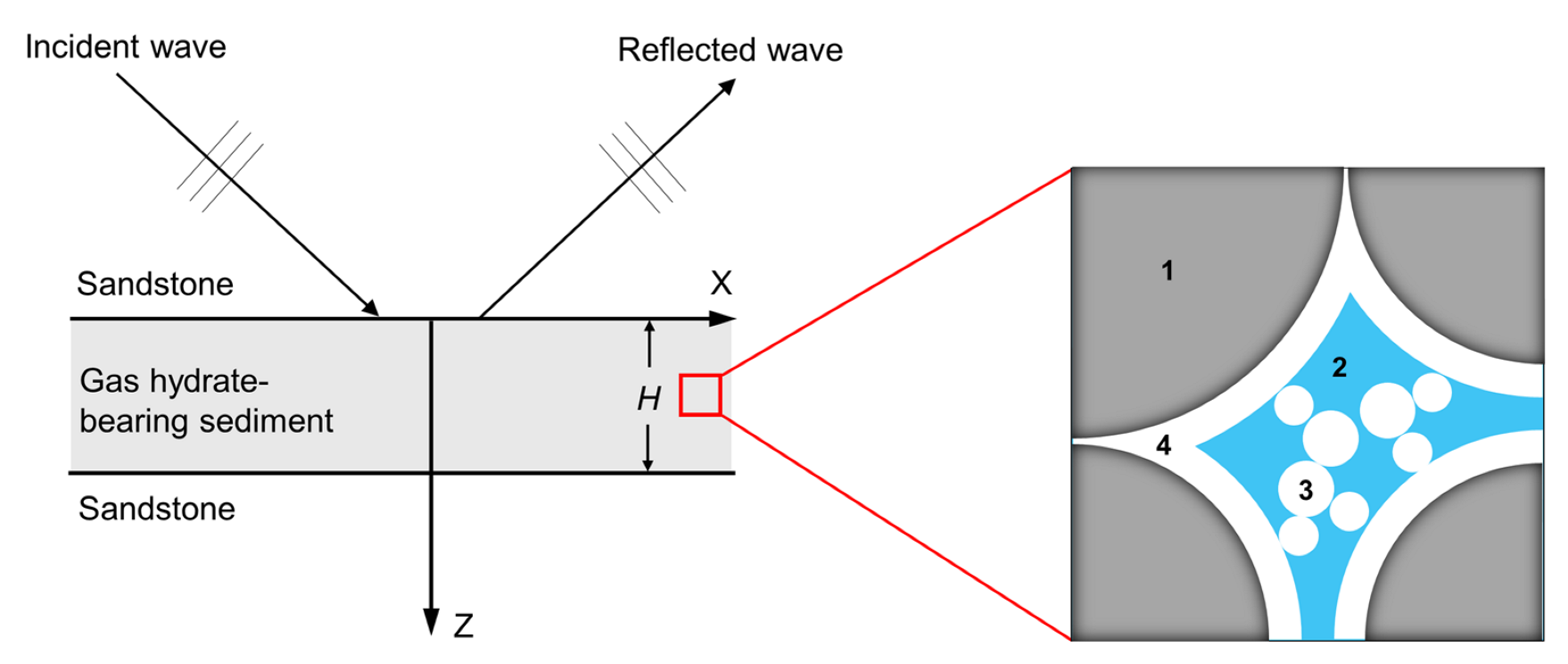


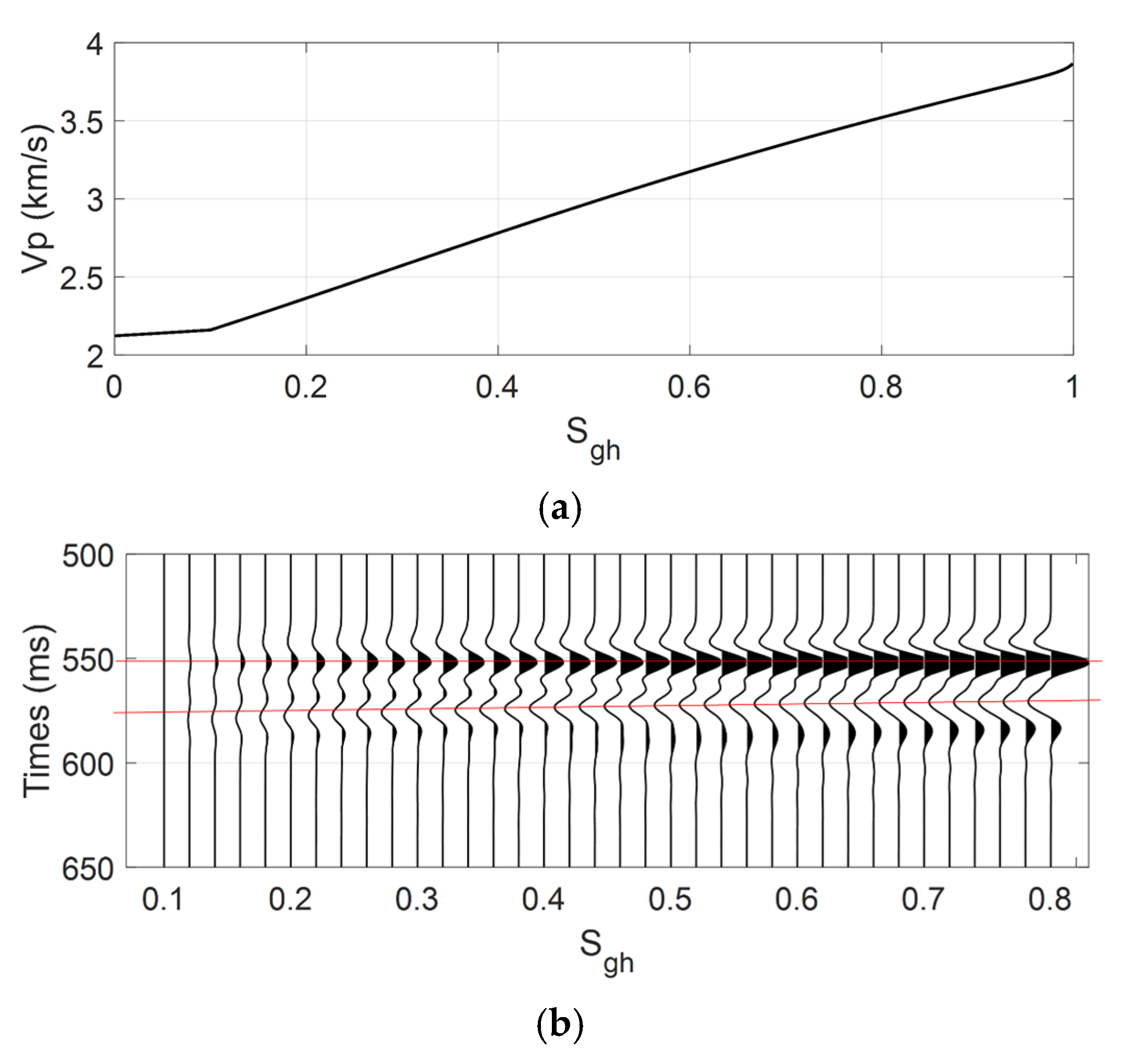
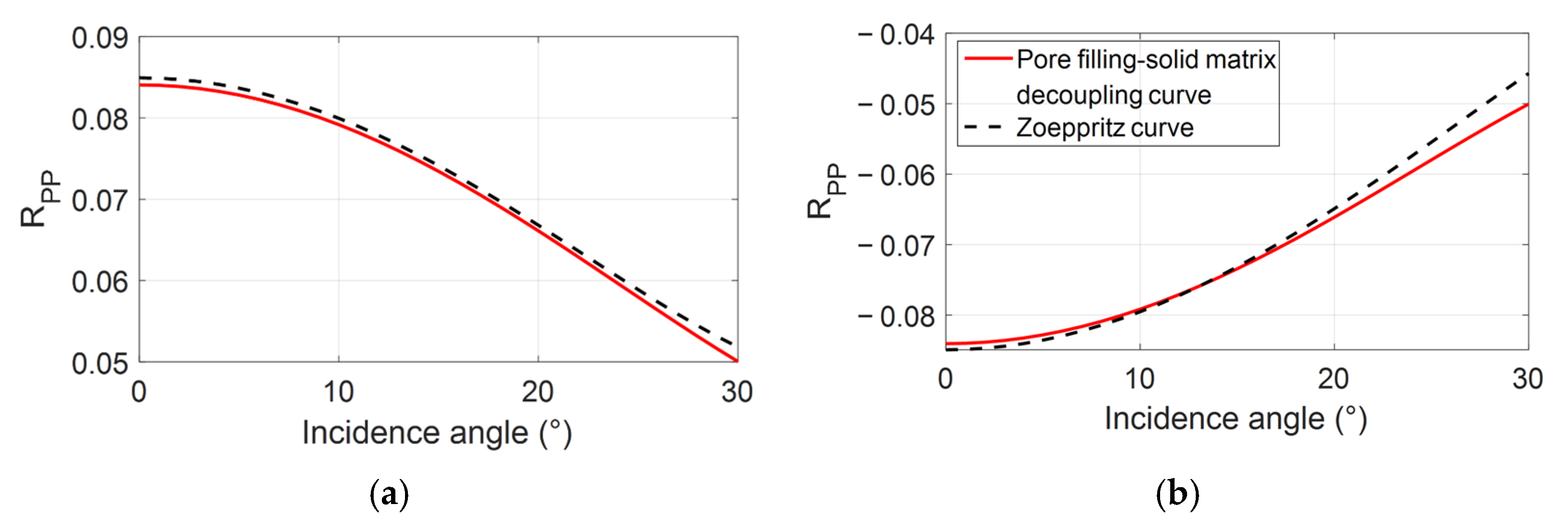
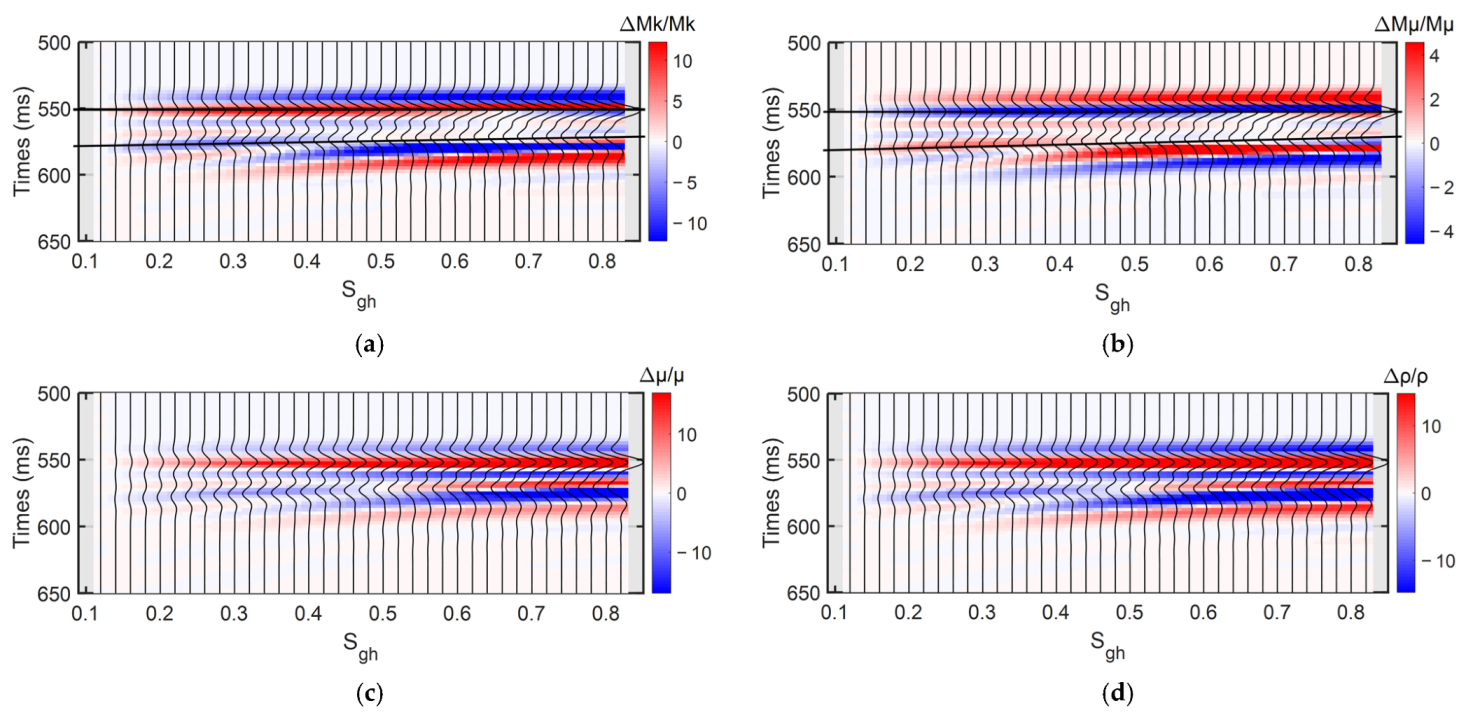
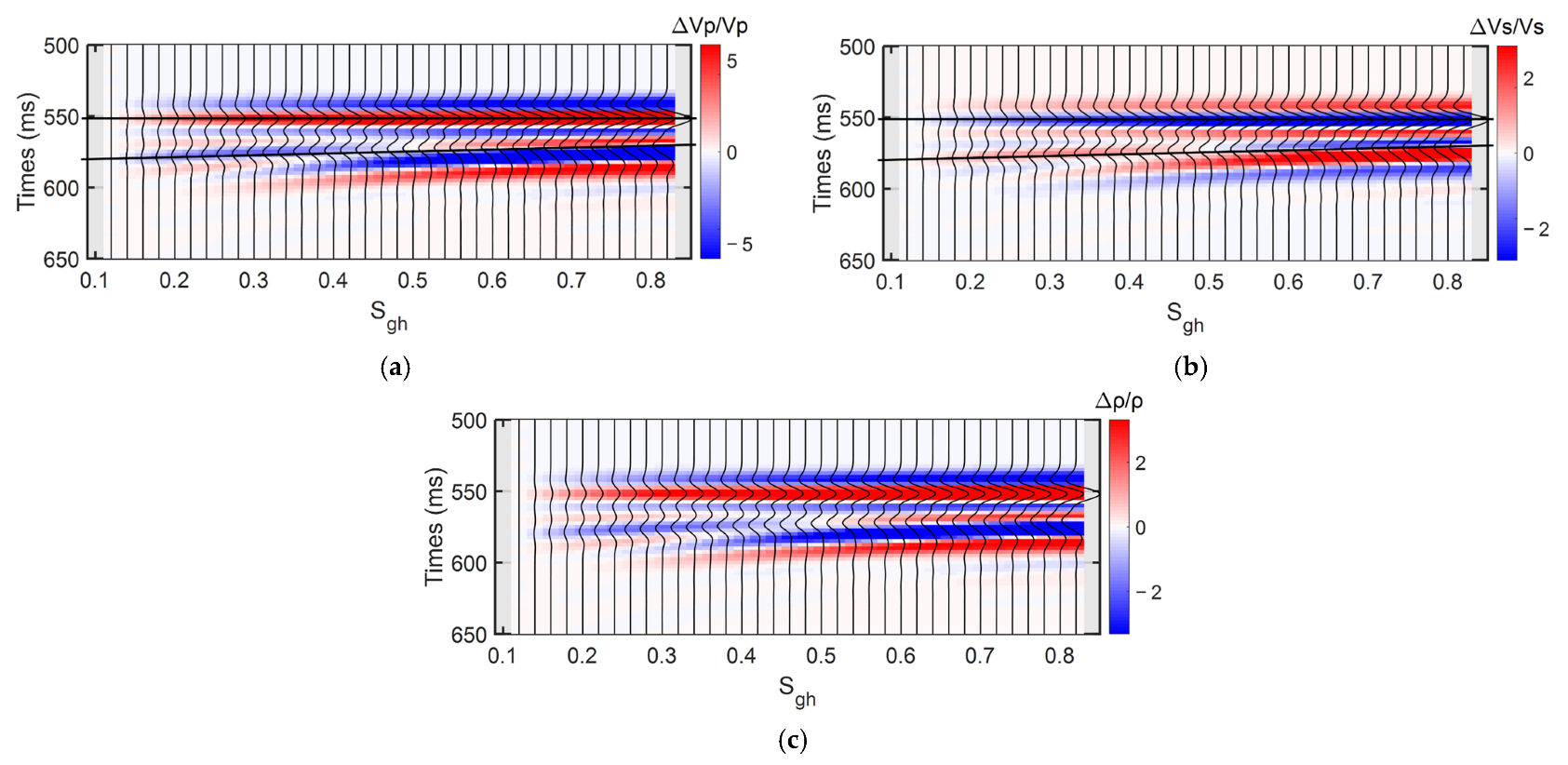
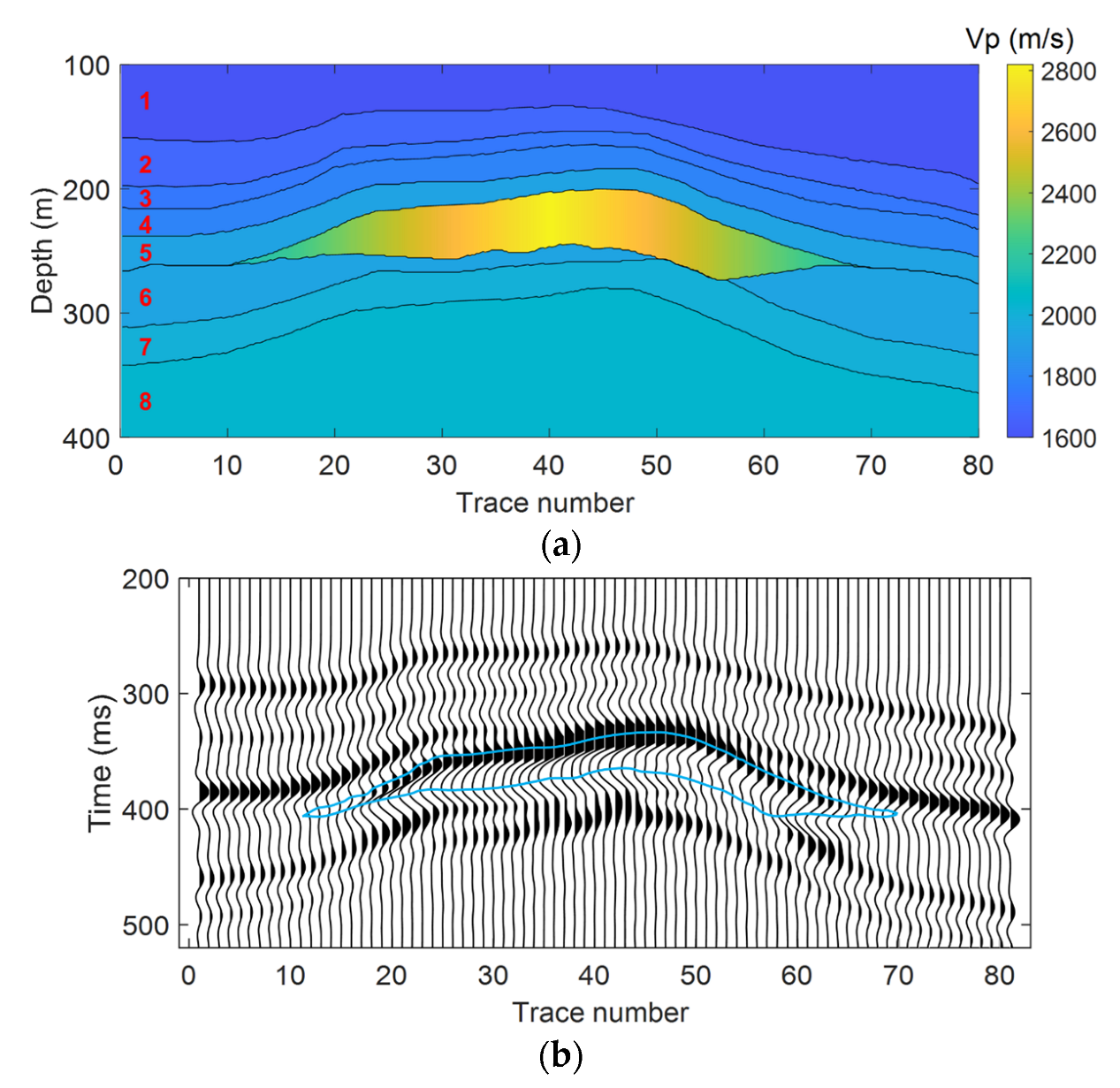


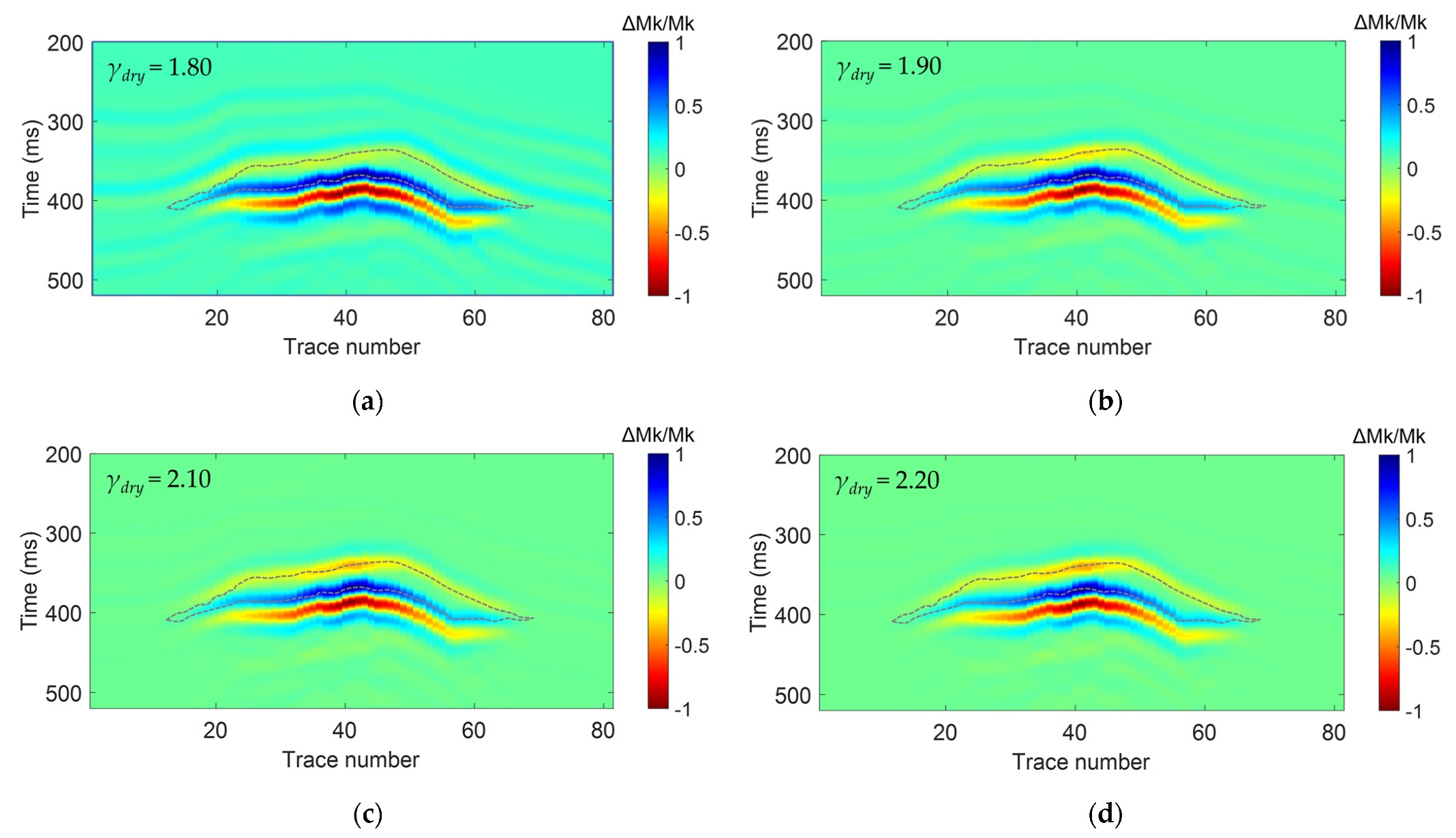
| VP (m/s) | ρ (kg/m3) |
|---|---|
| 1600 | 1740 |
| 1680 | 1760 |
| 1740 | 1770 |
| 1790 | 1790 |
| 1935 | 1870 |
| 1940 | 1880 |
| 2000 | 1920 |
| 2040 | 1940 |
Publisher’s Note: MDPI stays neutral with regard to jurisdictional claims in published maps and institutional affiliations. |
© 2022 by the authors. Licensee MDPI, Basel, Switzerland. This article is an open access article distributed under the terms and conditions of the Creative Commons Attribution (CC BY) license (https://creativecommons.org/licenses/by/4.0/).
Share and Cite
Guo, Z.; Lv, X.; Liu, C.; Chen, H.; Mei, L. Characterizing Gas Hydrate-Bearing Marine Sediments Using Elastic Properties—Part 2: Seismic Inversion Based on a Pore-Filling–Solid Matrix Decoupling Scheme. J. Mar. Sci. Eng. 2022, 10, 1497. https://doi.org/10.3390/jmse10101497
Guo Z, Lv X, Liu C, Chen H, Mei L. Characterizing Gas Hydrate-Bearing Marine Sediments Using Elastic Properties—Part 2: Seismic Inversion Based on a Pore-Filling–Solid Matrix Decoupling Scheme. Journal of Marine Science and Engineering. 2022; 10(10):1497. https://doi.org/10.3390/jmse10101497
Chicago/Turabian StyleGuo, Zhiqi, Xiaoyu Lv, Cai Liu, Haifeng Chen, and Lulu Mei. 2022. "Characterizing Gas Hydrate-Bearing Marine Sediments Using Elastic Properties—Part 2: Seismic Inversion Based on a Pore-Filling–Solid Matrix Decoupling Scheme" Journal of Marine Science and Engineering 10, no. 10: 1497. https://doi.org/10.3390/jmse10101497
APA StyleGuo, Z., Lv, X., Liu, C., Chen, H., & Mei, L. (2022). Characterizing Gas Hydrate-Bearing Marine Sediments Using Elastic Properties—Part 2: Seismic Inversion Based on a Pore-Filling–Solid Matrix Decoupling Scheme. Journal of Marine Science and Engineering, 10(10), 1497. https://doi.org/10.3390/jmse10101497







